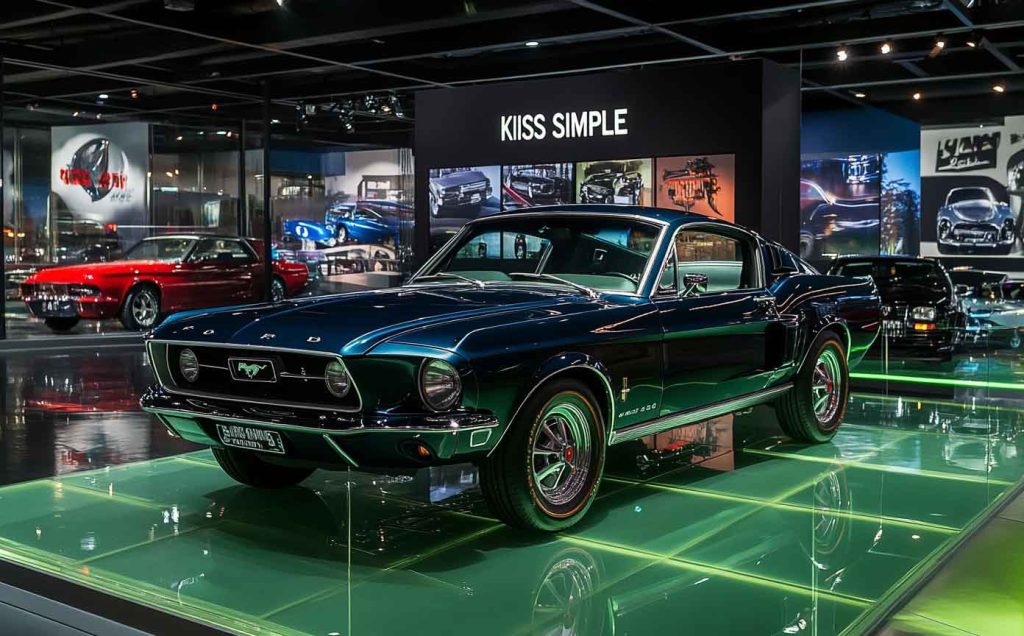Monday to Saturday - 9:00 am -18:00 pm

The Ford Mustang is one of the most iconic American muscle cars, blending raw power, vintage vibes, and modern flair. But not every model year was a hit—some years had serious issues that left owners frustrated with costly repairs, safety problems, or poor build quality.
Whether you’re shopping for a used Mustang or just curious about your car’s history, this article breaks down the worst Mustang years to avoid, explains why they’re problematic, and helps you spot common Mustang problems before you buy.
In this guide, you’ll get:
- A list of Ford Mustang years to avoid
- A detailed breakdown of the most troublesome model years
- Common complaints, recalls, and reliability issues
- Mustang generations with the most repair headaches
- Key tips on how to choose a reliable used Mustang
Let’s shift gears and dive in.

Ford Mustang Years to Avoid: Quick Reference List
Here’s a quick look at the Mustang years you may want to skip:
| Model Year | Common Problems | Reliability Rating |
|---|---|---|
| 2005 | Electrical issues, paint problems, engine hesitation | ★★☆☆☆ |
| 2006 | Interior wear, throttle body issues, airbag recalls | ★★☆☆☆ |
| 2010 | Transmission failures, engine knocking, poor ride quality | ★★☆☆☆ |
| 2011 | Engine misfires, ticking noises, AC issues | ★★☆☆☆ |
| 2012 | Alternator failures, interior electronics, power steering issues | ★★☆☆☆ |
| 2015 | Electrical gremlins, rough shifts, squeaky brakes | ★★☆☆☆ |
These years tend to pop up repeatedly in reliability reports, owner complaints, and recall databases.
Why Avoid These Mustang Years?
Let’s explore what went wrong with these specific Mustang years and how they affected performance, safety, and cost of ownership.
2005 Ford Mustang: Looks Great, Drives You Crazy
The fifth-generation Mustang debuted in 2005 with a retro-inspired design that wowed enthusiasts—but the excitement wore off quickly due to:
- Electrical gremlins: Dash lights flickering, power windows failing, and battery drain issues.
- Paint and body quality: Owners reported poor factory paint that chipped and faded early.
- Throttle hesitation: A laggy response from the gas pedal made driving less enjoyable.
If you’re considering a 2005 model, make sure these issues have been addressed by the previous owner.

2006 Ford Mustang: More of the Same Problems
The 2006 Mustang carried over many of the 2005 model’s flaws:
- Interior problems: Cheap plastic trim, loose panels, and early wear-and-tear.
- Airbag recalls: One of the early years affected by the Takata airbag recall crisis.
- Throttle body issues: Unresponsive acceleration and engine surging were common.
Although slightly improved over 2005, it still ranks low in reliability and owner satisfaction.
2010 Ford Mustang: Transmission Troubles Begin
The 2010 model was a visual refresh, but it didn’t solve key mechanical issues:
- Transmission failure: Owners complained of clunky or failing automatic transmissions.
- Engine knocking: Especially in the V6 variant, engine noise and performance problems were frequent.
- Harsh ride quality: Suspension tuning didn’t match expectations, making the ride rough.
While it had style upgrades, the 2010 model year didn’t improve reliability where it mattered.
2011 Ford Mustang: Engine Ticking & Misfires
The 2011 Mustang introduced the new 5.0L Coyote V8—but it came with its own set of problems:
- Engine ticking: A well-known issue that could indicate valve or timing chain issues.
- AC system failures: Many drivers reported malfunctioning air conditioning systems.
- Transmission jerks: Shifting was inconsistent and led to rough rides.
If buying used, it’s crucial to inspect engine and transmission health thoroughly.
2012 Ford Mustang: Power Problems Persist
The 2012 Mustang continued to struggle with reliability issues despite minor improvements:
- Alternator failures: A major pain point, with many reports of battery drain and electrical system issues.
- Steering malfunctions: The introduction of electric power steering led to assist failures and warning lights.
- Interior electronics: Malfunctions in displays, radios, and dashboard systems caused frustration.
While the 5.0L engine gained fans, the supporting systems didn’t live up to the hype.
2015 Ford Mustang: First-Year Woes of a New Generation
The sixth generation launched in 2015 with independent rear suspension and a sleek new design, but it came with first-year hiccups:
- Electrical glitches: Backup cameras, sensors, and infotainment systems were unreliable.
- Rough shifting: Especially with the 6-speed automatic, owners experienced jerky or delayed gear changes.
- Brake noise: High-pitched squeals and premature wear were common complaints.
Being the first of its generation, the 2015 model suffered from growing pains. Later years improved, but this one’s best approached with caution.
What Are the Most Reliable Mustang Years?
On the flip side, here are some Mustang model years known for better reliability and owner satisfaction:
| Model Year | Highlights | Reliability Rating |
|---|---|---|
| 2014 | Strong 5.0L V8, few complaints, stable electronics | ★★★★☆ |
| 2016 | Improved transmission, smoother ride | ★★★★☆ |
| 2017 | Refined tech, fewer recalls | ★★★★☆ |
| 2019 | EcoBoost and GT models praised for power and refinement | ★★★★★ |
| 2021 | Improved build quality, excellent performance balance | ★★★★★ |
These years reflect Ford’s fine-tuning of technology and build quality after resolving earlier generation flaws.
How to Choose a Used Ford Mustang Wisely
Buying a used Mustang? Here’s a quick guide to avoid costly surprises:
✔️ Check the VIN for Recalls
Use a VIN lookup tool (like the one at NHTSA.gov) to check for unresolved recalls, especially for 2005–2012 models.
✔️ Review Maintenance Records
A well-documented service history is a green flag. Look for oil changes, brake jobs, and any major repairs.
✔️ Watch for Engine Noise
Avoid ticking, knocking, or misfires, especially in 2011–2012 Mustangs with the 5.0L V8.
✔️ Test the Transmission
Make sure the gear shifts are smooth. Jerks, delays, or slippage are red flags in models like 2010 and 2015.
✔️ Inspect the Electronics
Check the dashboard lights, infotainment, backup camera, and power accessories.
Common Ford Mustang Problems to Watch Out For
Regardless of the year, some issues pop up more frequently in used Mustangs. Keep an eye out for:
| Problem Area | Description |
|---|---|
| Electrical Systems | Failing alternators, battery drain, power window glitches |
| Transmission | Hard shifts, delayed engagement, transmission fluid leaks |
| Engine Ticking | Especially in 5.0L Coyote engines (2011–2012) |
| Interior Quality | Peeling trim, rattling panels, squeaky plastic surfaces |
| Suspension Wear | Noisy bushings, rough ride, clunking noises over bumps |
| Air Conditioning | Blowing hot air, compressor failure, sensor malfunctions |
These issues don’t necessarily mean every Mustang is a lemon—but they do warrant a thorough inspection.
Mustang Generations and Reliability Overview
Let’s take a quick look at how each Mustang generation stacks up:
| Generation | Years | Reliability Verdict |
|---|---|---|
| Fifth (S197) | 2005–2014 | Mixed: Early years (2005–2006) problematic; 2011–2012 had engine issues |
| Sixth (S550) | 2015–2023 | Improved: First-year 2015 buggy; 2016+ more refined |
| Fourth (SN95/New Edge) | 1994–2004 | Generally solid but aging; electrical issues more common now |
Final Thoughts
Absolutely—but you’ve got to be picky.
The Ford Mustang is a muscle car legend, offering style, performance, and heritage in one package. But like any long-running model, some years had more misses than hits. By avoiding the most problem-prone models and focusing on years with strong reliability records, you can enjoy the Mustang experience without the stress.
Pro Tip: Consider having a trusted mechanic do a pre-purchase inspection. It’s a small investment that could save you thousands.
Frequently Asked Questions (FAQs)
❓ What year Mustangs have the most problems?
The 2005, 2006, 2010, 2011, 2012, and 2015 models are often flagged for engine, transmission, and electrical issues.
❓ Is the 2015 Mustang a good car?
It introduced a new design and rear suspension, but early models had bugs. Later years (2016+) improved reliability.
❓ Are older Mustangs worth buying?
They can be, especially if well-maintained. Be cautious with 2005–2006 models and always check for recalls.
❓ What is the most reliable Mustang engine?
The 5.0L Coyote V8 (2013+) is highly regarded for performance and durability—if properly maintained.
❓ How many miles is too many for a used Mustang?
Look for Mustangs under 120,000 miles with a solid service record. High mileage isn’t always bad, but reliability depends on maintenance.
Final Gear Shift
If you’re set on owning a Ford Mustang, steer clear of the problem years, ask questions, and do your homework. When you land on the right year and trim, it’ll be a ride worth taking.
Have more questions about specific Mustang models or need help checking a VIN? Drop them in the comments or contact us for a quick Mustang model analysis.